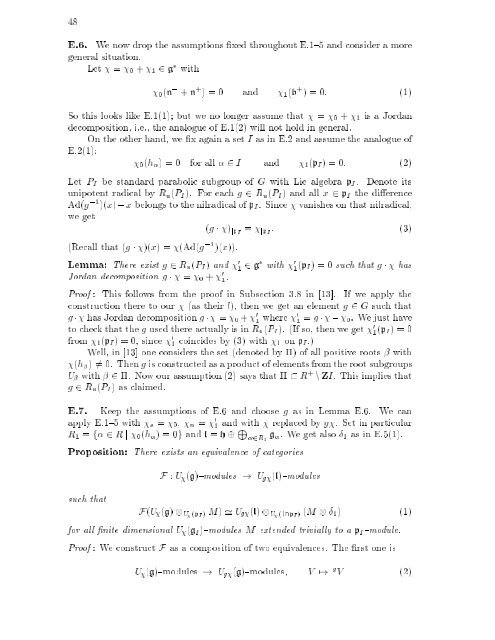subregular nilpotent representations of lie algebras in prime ...
subregular nilpotent representations of lie algebras in prime ...
subregular nilpotent representations of lie algebras in prime ...
You also want an ePaper? Increase the reach of your titles
YUMPU automatically turns print PDFs into web optimized ePapers that Google loves.
48<br />
E.6. We now drop the assumptions xed throughout E.1{5 and consider a more<br />
general situation.<br />
Let = 0 + 1 2 g with<br />
0(n , + n + )=0 and 1(b + )=0: (1)<br />
So this looks like E.1(1); but we no longer assume that = 0 + 1 is a Jordan<br />
decomposition, i.e., the analogue <strong>of</strong> E.1(2) will not hold <strong>in</strong> general.<br />
On the other hand, we x aga<strong>in</strong> a set I as <strong>in</strong> E.2 and assume the analogue <strong>of</strong><br />
E.2(1):<br />
0(h )=0 for all 2 I and 1(pI) =0: (2)<br />
Let PI be standard parabolic subgroup <strong>of</strong> G with Lie algebra pI. Denote its<br />
unipotent radical by Ru(PI). For each g 2 Ru(PI) and all x 2 pI the di erence<br />
Ad(g ,1 )(x),x belongs to the nilradical <strong>of</strong> pI. S<strong>in</strong>ce vanishes on that nilradical,<br />
we get<br />
(Recall that (g )(x) = (Ad(g ,1 )(x)).<br />
(g ) jpI = jpI : (3)<br />
Lemma: There exist g 2 Ru(PI) and 0 1 2 g with 0 1(pI) =0such that g has<br />
Jordan decomposition g = 0 + 0 1 .<br />
Pro<strong>of</strong> : This follows from the pro<strong>of</strong> <strong>in</strong> Subsection 3.8 <strong>in</strong> [13]. If we apply the<br />
construction there to our (as their l), then we get an element g 2 G such that<br />
g has Jordan decomposition g = 0 + 0 1 where 0 1 = g , 0. Wejusthave<br />
to check that the g used there actually is <strong>in</strong> Ru(PI). (If so, then we get 0 1(pI) =0<br />
from 1(pI) = 0, s<strong>in</strong>ce 0 1 co<strong>in</strong>cides by (3) with 1 on pI.)<br />
Well, <strong>in</strong> [13] one considers the set (denoted by ) <strong>of</strong> all positive roots with<br />
(h ) 6= 0. Then g is constructed as a product <strong>of</strong> elements from the root subgroups<br />
U with 2 . Now our assumption (2) says that R + n ZI. This imp<strong>lie</strong>s that<br />
g 2 Ru(PI) as claimed.<br />
E.7. Keep the assumptions <strong>of</strong> E.6 and choose g as <strong>in</strong> Lemma E.6. We can<br />
apply E.1{5 with s = 0, n = 0 1 and with replaced by g . Set <strong>in</strong> particular<br />
R1 = f 2 R j 0(h )=0g and l = h L 2R1 g .Weget also 1 as <strong>in</strong> E.5(1).<br />
Proposition: There exists an equivalence <strong>of</strong>categories<br />
such that<br />
F : U (g){modules ! Ug (l){modules<br />
F(U (g) U (pI) M) ' Ug (l) U (l\pI) (M 1) (1)<br />
for all nite dimensional U (gI){modules M extended trivially to a pI{module.<br />
Pro<strong>of</strong> :We construct F as a composition <strong>of</strong> two equivalences. The rst one is<br />
U (g){modules ! Ug (g){modules; V 7! g V (2)

















